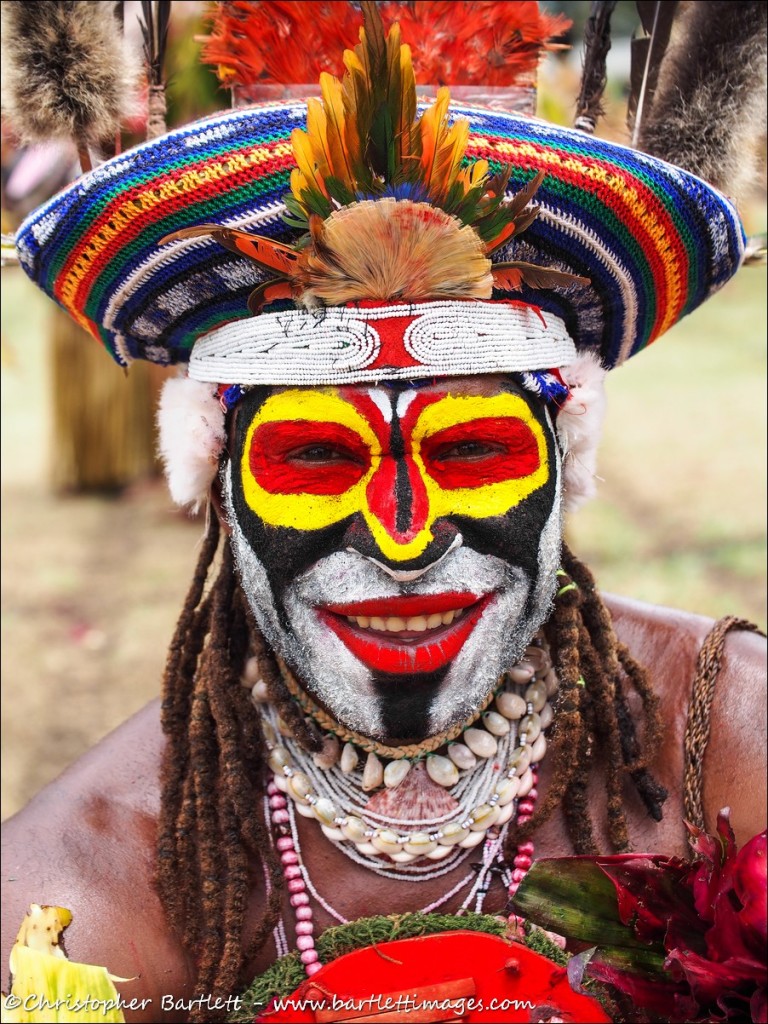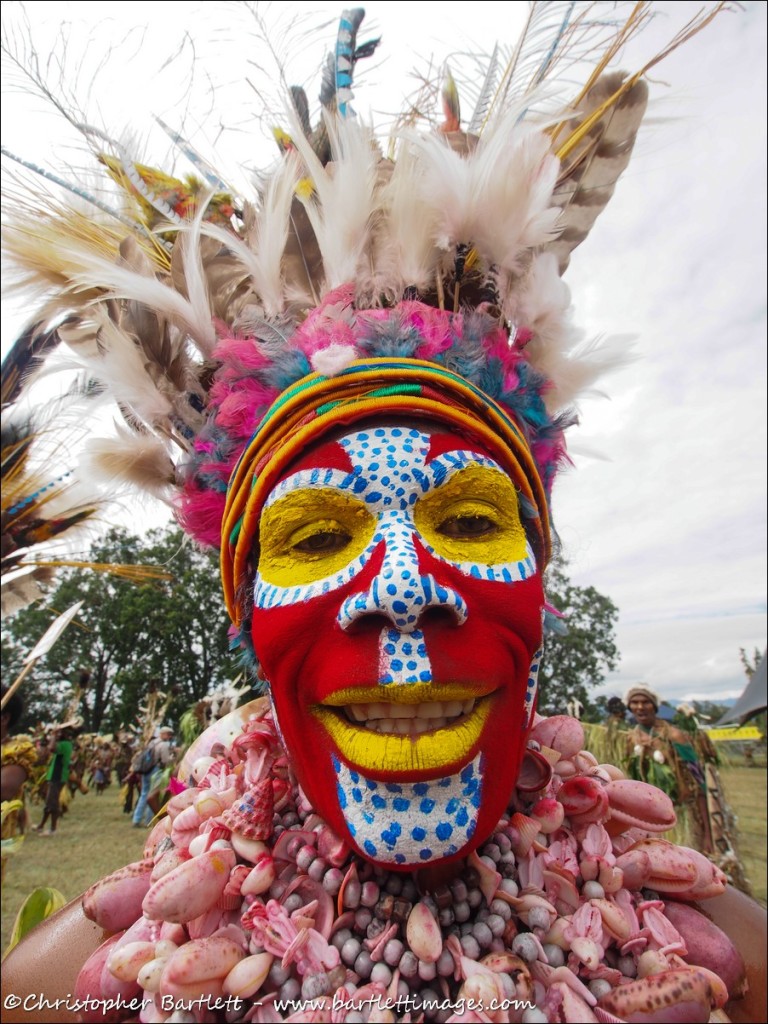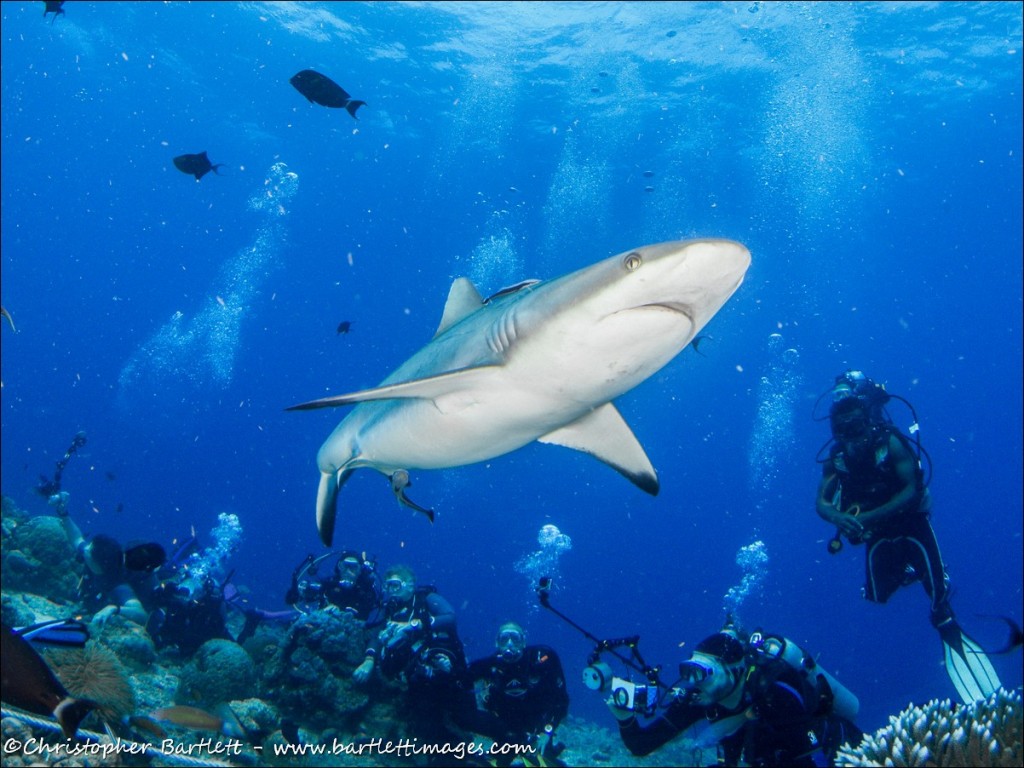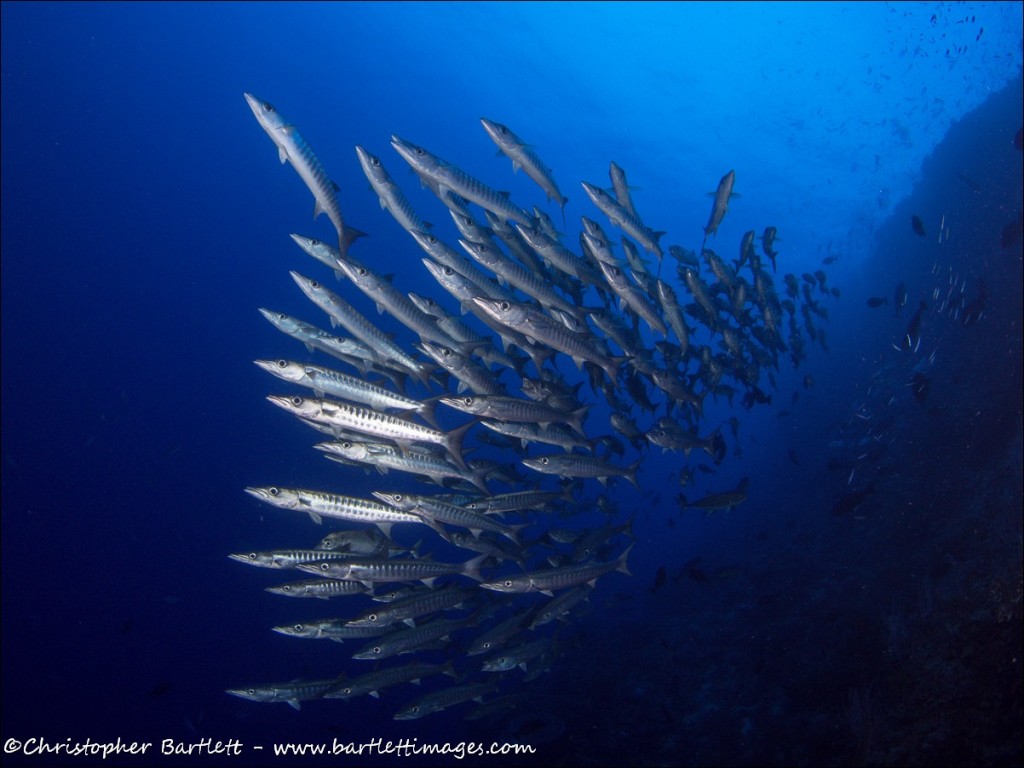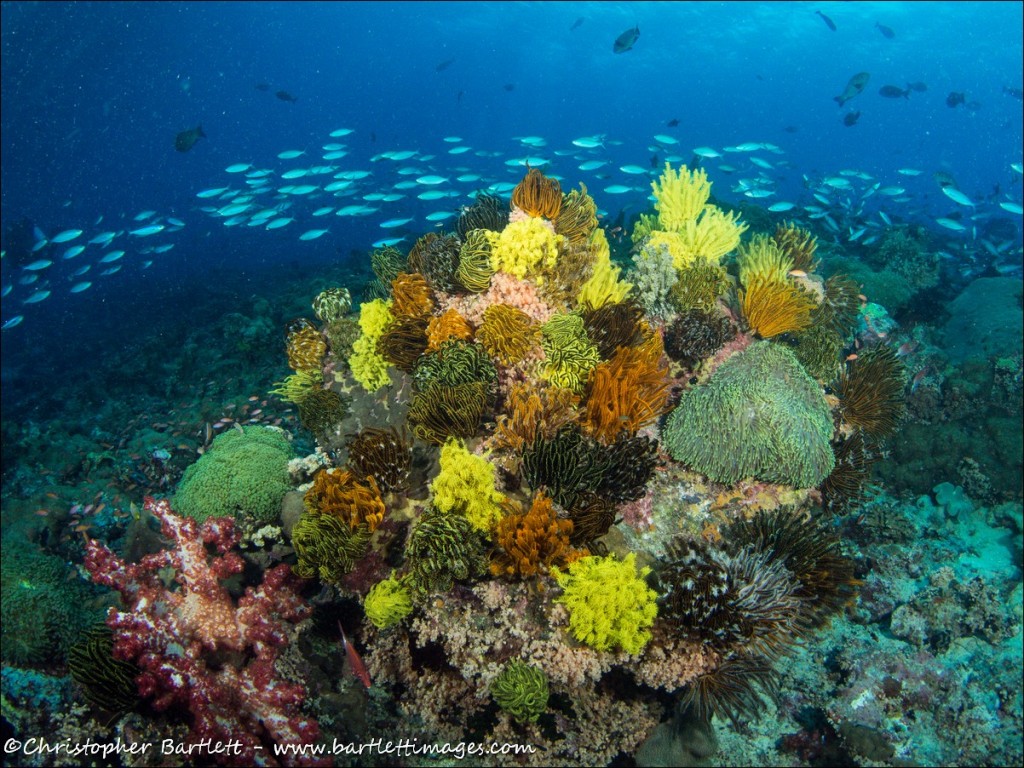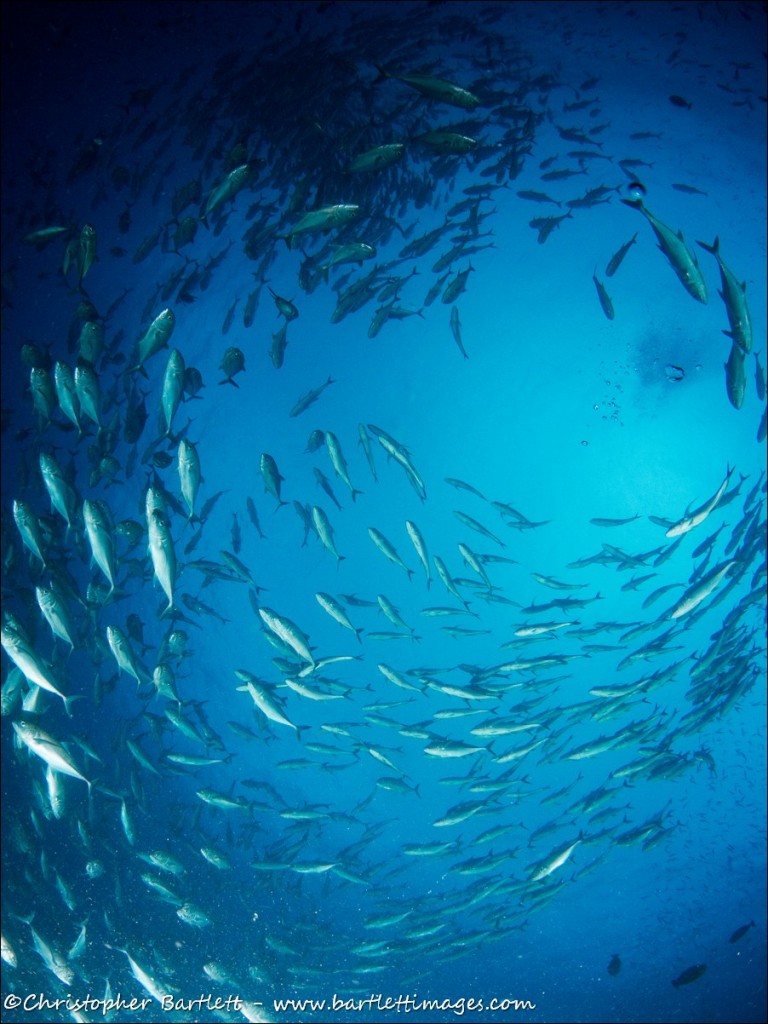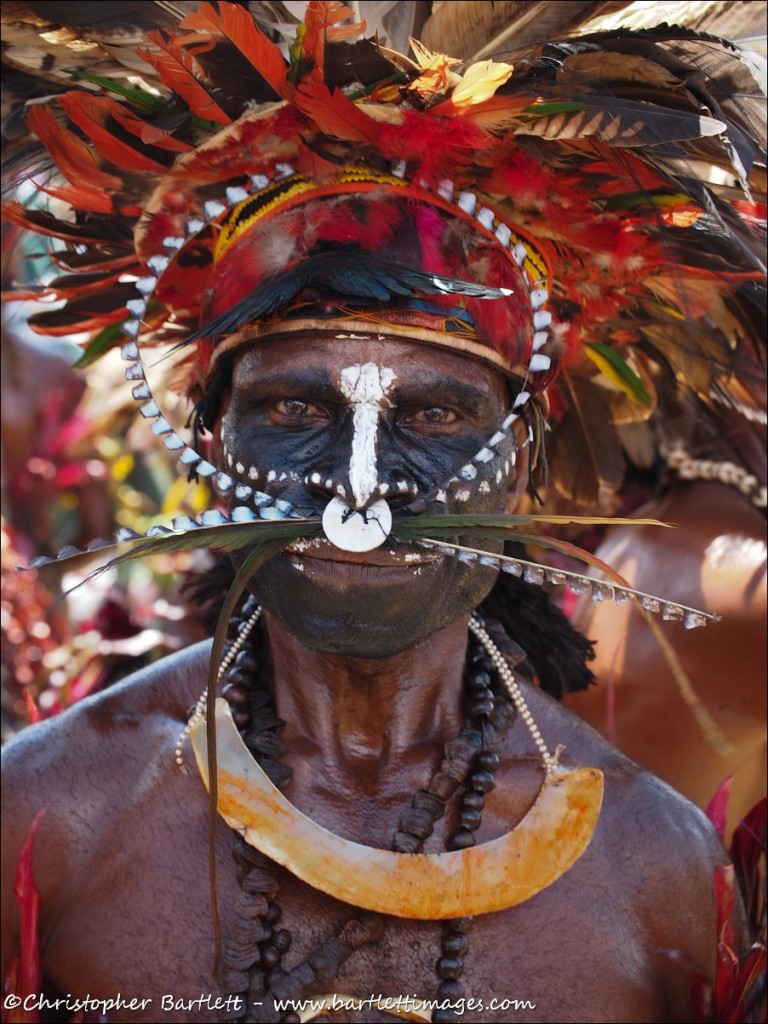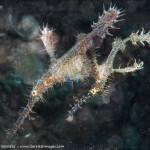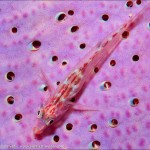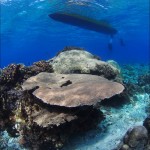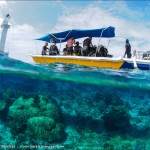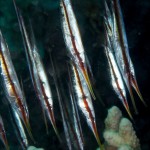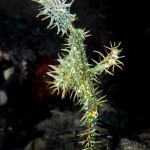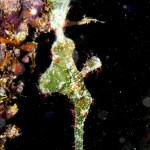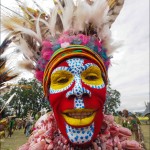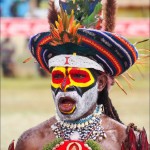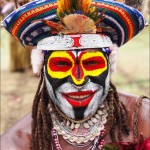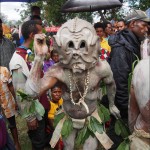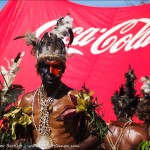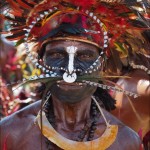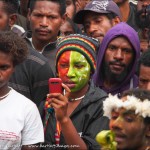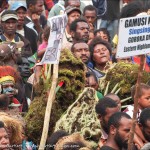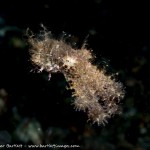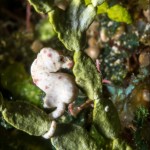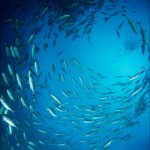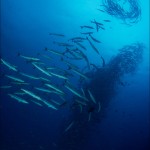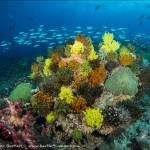Is there another country anywhere with so much diversity? The six million inhabitants of this nation of mountains and islands are spread over 463,000 km2 of mountainous tropical forests, and speak over 800 different languages (12% of the world total). Papua New Guinea occupies half of the third largest island in the world and 160 other islands and 500 named cays.
Located just south of the equator and to the north of Australia, PNG is a diver’s paradise with the 4th largest surface area of coral reef ecosystem in the world (40,000 km2 of reefs, seagrass beds, and mangroves in 250,000 km2 of seas), and underwater diversity with 2500 species of fish, corals, and molluscs. There are more dive sites than you can shake a stick at, with many more to be discovered, and barely a diver on them. The dive centres are so far apart that there is only ever one boat at any dive site.
It is one of the few places left in the world where a diver can see macro critters, pelagics, and big stuff, as well as fantastic soft and hard corals. The often misused and abused adjective “pristine” is actually appropriate here, due to low fishing pressure in the area in comparison to other areas of the Coral Triangle, no dynamite fishing, and thanks to a system implemented by dive resorts whereby local reef “owners” receiving a small fee for every diver that visits “their” reef. As a result elders make sure that the reefs are not fished.
So, where to go? We set of on a four-resort tour to the north and the south taking in the provinces of Milne Bay, Oro, and New Ireland.
TUFI
Sitting at the back of the De Havilland Twin Otter with my partner Imi and an American Mom, Dad, and teenage son combo in front, I peered through the misty clouds at the swath of trees below, occasionally cut by the hairline crack of a path or the meandering swirls of a river. The jagged peaks of the Owen-Stanley range that run down the spine of the island weren’t that far away as we headed east from Port Moresby to Tufi. The landscape was rugged to say the least, and it was easy to understand why both Australian and Japanese troops had struggled during the Second World War battles there.
As we approached the east coast of Oro province the spectacular fjords of Cape Nelson came into view, a strange mix of glacial action now topped by lush tropical forest, with aqua coral reefs surrounding the headlands clearly visible in the cobalt blue of the Solomon Sea. Banking steeply, we lined up with the gravel airstrip and touched down. Two 4WD vehicles were waiting for us to take us on the one-minute drive to the resort.
With a fruit juice in hand, we whizzed through the usual paperwork and were asked to leave our dive gear outside out rooms in 20 minutes and meet in reception from where we were taken down to the dive centre. Less than 90 minutes after landing the five of us, plus instructor Glen and DM Alex, were in a boat and heading off across the flat sea to Bev’s reef, part of the mid-distance reef system, and one of the several Tufi reefs with a manta cleaning station. Using a well-drawn dive site map, Glen laid out the plan for a drift dive, and of we went.
Imi hadn’t dived for four months and I had the new camera so we were planning on just chilling and getting comfortable again, and a wall dive seemed ideal. Rolling in we both burst into grins. Not just from the simple pleasure of being in the water again, but because of the clear blue water filled with corals, reef fish, and colourful purple, yellow, and white sea squirts. There were nudis and schools of fusiliers and snappers, whitetip reef sharks and three of the nine species of anemonefish found in PNG.
Wending our way slowly at the back of the group, coming over the top of a coral outcrop to have gander for big stuff that might be hanging out in the current I had to do a double take. Sitting there next to a crinoid was one of PNG’s underwater grails, a black Merlet’s (or lacy) scorpionfish, Rhinopias aphanes, that has the peculiar habit off shedding its skin every three months or so. Photographers search for these for days and days, and here I was pointing an unfamiliar camera at one after barely 30 minutes in the water. It turned out to be the first of two that saw, but it was the start of a long list of new sightings for me.
One of Tufi’s signature sites is Veale’s reef, often dived on the same trip as Bev’s. Veale’s is often frequented by an albino hammerhead, but not on this occasion. Still, it was hard to grumble with of schools of baitfish, barracuda, black and white snapper, batfish, some Spanish mackerel, as well as a swift-moving green turtle and a couple more whitetips around. We certainly had enough to talk about over a late but delicious lunch on the veranda.
Some reefs are just a short trip away, such as Blue Ribbon reef just round the runway headland that we dived during a tropical storm. The sea turned an atmospheric deep blue as we searched for, you guessed it, ribbon eels. Not all ribbon eels are blue, far from it in fact. They are all born black with a yellow dorsal stripe, adult females are yellow with a black anal fin with white margins on the fins and only adult males are blue with a yellow dorsal fin.
The outer reefs are a 30-minute boat ride away and Cyclone reef is one of them. The story goes that it appeared from nowhere after a severe storm in 1972, brought up from the depths by the elements. It’s very top breaks the surface of the sea and is a haven for mating seabirds. Over the edge it drops away into a wall dive, once again buzzing with reef life, and out in the blue we spied two hammerheads cruising past. Minor reef is nearby and often dived in tandem with Cyclone. The reef top sits a few metres below the surface and its plate and staghorn corals bask in the sunlight illuminating the damselfish that adorn them, making it a great spot for no-flash photography. It is named after the large bright yellow and black Notodoris minor nudibranch that is often found there.
Back at the resort, looking at the maps on the walnut-panelled walls gives one a better sense of the remoteness and the size of the area. Whole swathes of the Solomon Sea, starting where Cyclone and Minor reefs are, are marked as uncharted. There are basically reefs everywhere out there. Jack Daniels and Nuggets are two recently discovered ones, and Glen and his brother Archie were keen to get us out to them. Armed with a small plastic bottle with a little water in it, Archie began crunching and rolling it between his hands as soon as we were down JD’s slope and onto the wall. Within a couple of minutes he had attracted the attention of four grey reef sharks. They didn’t seem very used to human interaction and kept their distance, as did a couple of turtles, the sharks occasionally darting a bit closer to recce these odd, large bubble-blowing creatures, and a couple of whitetip reef sharks came by for a look too.
With our appetites for diving well and truly whetted, we went for an afternoon dive off the public wharf. It is talked up as a photographer’s delight and one of the best spots in the world for so-called muck-diving. Muck-diving gets its name from apparently uninteresting sites that can be either silty, sandy, muddy, or just rather barren-looking, but that are actually home to a large number of small, weird, and wonderful creatures.
Tufi’s wharf dive site is more of a junk dive than a muck dive, the sloping wall of the fjord being littered with debris from the harbour’s previous life as a torpedo patrol boat base during WW2, and the dumping of old bits of machinery, the odd fuel drum, and some girders that were no doubt formerly part of the jetty. There are also the remains of PT boat and its torpedoes down at 45 metres, but there was more than enough along the fjord slope and wall to keep us occupied with ornate and robust ghostpipefish, frogfish, ringed pipefish, common seahorse, loads of nudis, crab eye gobies, anemonefish, mantis shrimp, cleaner shrimp, lionfish, and 50 metres past the remains of the torpedo boat wharf, walls, little caves, and tons of sponges on the corner of the harbour. If you fancy a fourth dive in a day, dusk dives are available, and Alex and Archie the eagle-eyed guides are experts at finding nocturnal action right by the wharf, including brightly-patterned mandarinfish.
If three or four dives a day is a bit too much, there is plenty to do to fill your time actively. On the Sunday we were paddled up McLaren Sound in an outrigger and advanced into the forest until it became too shallow to make further progress. After a short walk we were given an insight into village life, traditions, the uses of various plants and trees, and demonstrations of tattooing and sago-making before being paddled back to the dive boat that whisked us to a white sand beach on the headland opposite the resort for a barbecue lunch and afternoon swim.
In the afternoon you can also walk through the village or amble down to the dock, and watch the locals from the surrounding area come in on their outriggers for a trip to the store by the wharf or to trade in the village. There is a steady trickle of comings and goings if people watching is your thing, but the main event is the Saturday evening wharf market that springs up when the weekly ferry comes in from Popandetta. That said, I would have gladly dived the sites we did over and over again; every dive was “Wow dive”.
On our final afternoon we took a two-seater canoe and paddled up the fjord, hearing the sounds of the forest as we went. We canoed the deep blue in the centre of the fjord, apparently bottoming out around 200 metres below, and would pop over to the shallow reef tops for a dip and a snorkel. At many of the small beaches we’d see an outrigger parked up and hear voices in the distance, mainly children whooping with laughter, frolicking unseen in the trees. It is certainly a place that should inspire happiness.
NEW IRELAND
Two hours’ flight north-east of Port Moresby, with a 10-minute stop in West New Britain near the site of PNG’s last volcanic eruption, lies Kavieng, the capital of New Ireland province. Located at the northern tip of a 380-kilometre long island, sleepy Kavieng and its 11,000 inhabitants hold few attractions for most of the trickle of tourists who venture here to dive and to surf and no accommodation worth staying in. Yet if you like wandering around dusty betel nut-stained streets and dim and musty shops, an afternoon in town after a dive is an interesting experience and was another opportunity to experience the friendly nature of the locals.
New Ireland’s diving has a reputation for pelagics and sharks that are attracted by the fresh deep water that is flushed between the multitude of small islands and passages making up the area dogtooth tuna, Spanish mackerel, trevally, and barracuda, and blacktip, whitetip, silvertip, and grey reef sharks all came out to play. New Ireland also has a good mixture of vibrant and colourful reefs, a few interesting muck-diving sites, and WW2 plane wrecks aplenty such as the trevally and anemone festooned Echuka Patch and the Der Yang shipwreck and Japanese Pete and Jake float planes, stationed here when Kavieng was under wartime occupation, and the remains of a Catalina flying boat and several unexploded bombs.
The Bismark Sea are well worth the trip through the islands and mangroves. Albatross passage has stunning soft coral coverage and a wide range of fish, with pygmy seahorses, cuttlefish, dogtooth and sharks. On an incoming tide it is a truly excellent dive, down by the wall and on the sandy shelf it is calm but ends with a safety stop on reef hooks watching the action below as the current pumps past. On the way back the B-25 Stubborn Hellion awaits in 12 metres of water on the edge of the mangroves. 68 years after crashing into the sea after sustaining damage in a bombing raid on Kavieng, she is in remarkably good condition, with a spinecheek anemonefish manning the twin-machineguns in the top aft turret. The current can also adversely affect visibility on occasion, and we caught what was described by both dive centres as unusually poor viz. It is all relative though, and a measure of how good it usually is; the very worst we had was 15 metres.
The best accommodation option is Lissenung Island, a tiny island twenty minutes boat ride from Kavieng towards the Bismarck Sea. Owned by Austrian ex-engineer Dietmar Amon and his wife Ange, it’s seven rooms are ideally located for diving the Bismarck sites like Peter’s Patch and its batfish and pelagics, Helmut’s Reef, the leaf fish and white-bonnet anemonefish at Danny’s Bommy, the long wall at Kavin II, Matrix and its whip and soft branching coral, and of course Albatross. They are all excellent sites with varied topography, amazing tiny critters like halemeda and orang-utan crabs, abundant longnose hawkfish, schools of one-metre humphead parrotfish, more pygmy sea horses, tiny crinoid-dwelling squat lobsters and horned shrimps, and panda anemonefish. We dived some of them several times, and would happily return to them repeatedly, although if a choice had to be made Albatross and its wall overgrown with big fan corals, black corals and sponges just pips the others.
Several times a year Lissenung’s twin-engined 26-foot Ozycat heads northwards to New Hanover on expeditions to explore virgin reefs, a Japanese two-man submarine, and Chapman’s reef and its resident giant groupers, staying in guesthouses on different islands depending on the itinerary.
Lissenung Island’s 400 x 100 metres are only occupied by the seven-room resort, has a “no guests under 12” policy, and can be walked around in ten minutes. Basically guests share Dietmar and Ange’s private island paradise, with sandy and well-kept gardens, a small but perfect white sand beach with several seahorses basking in the shallows, and each room facing the sea.
The staff live on the neighbouring island of Enuk, and tours can be arranged to the village and school, whose development that the philanthropic owners have been heavily involved in. In the evening the office doubles up as a clinic as locals come in to have a variety of minor injuries dealt with. The usual routine sees the dive boat leave after breakfast and return for lunch. Afternoon and dusk dives leave daily, and a secret location is home to more mandarinfish mating after sunset. Afternoon dives on the house reef that goes two-thirds of the way around the island are free, and much of the best stuff is in three metres of water, making it ideal for snorkelling too. It doesn’t take too much luck to get a glimpse of juvenile blacktip reef sharks around the far side of the island.
WEST NEW BRITAIN
Walindi Plantation Resort, established in 1983, is an intimate dive resort situated on the shores of Kimbe Bay on the island of New Britain, Papua New Guinea. Celebrating over 25 years of operation, the resort is world famous for its quality of diving, international award-winning photography and warm hospitality. The resort’s guest book reads like a Who’s Who in the world of Sport Diving and Underwater Photography and the resort has been voted to have the “best diving from a resort anywhere in the world” by reader surveys. Earlier this year National Geographic’s David Doubilet was asked to choose where he wanted to shoot the 125th anniversary edition’s underwater feature. He chose Kimbe Bay.
With around 1000 species of fish and ¾ of the world’s known corals, Kimbe Bay has 40 dives sites that are a riot of colour and life. Underwater seamounts rise from over 1000 metres deep, stopping just below the surface, and attract schools of barracuda and jack, reef sharks, and turtles. Some of the reef tops are only two metres deep and are covered in hard corals and shimmering reef fish. Photographically spectacular, underwater images taken in the bay have consistently won the most prestigious underwater photography competitions in the world. As well as stunning wide-angle opportunities, there is plenty for the macro enthusiast too. Just tell the guides what critters you like and they will do their best to find them. I pulled out a book, pointed to an elegant squat lobster and requested one, but not the white and black one in the book, I wanted an orange one. Three days later I got a tap on the shoulder and a follow me, and hey presto, there it was….
The resort has 12 bungalows spread over the lush, green property and 8 plantation house rooms, and nitrox, a rarity in PNG, is available here.
The resort is also the home port of the MV Febrina. Purchased and converted in 1991, MV FeBrina is 73 feet of liveaboard comfort and convenience. She is a stable and extremely seaworthy motor vessel, well set out and catering for serious divers and photographers who want a total PNG dive experience.
FeBrina’s crew are locally trained as divers, and they specialise in combining excellent service and meals in combination with the ultimate diving experience. The crew are friendly and humble, always ready to offer a smile and a helping hand, under the watchful eye of cruise director and dive guide Josie. Digger is the other main dive guide, he has been blowing bubble for 23 years and they are extraordinarily good “spotters” often pointing out elusive and rarely seen critters. And there are plenty of finds to be made. In October I found an unknown species of burrowing night shrimp, a tiny squat lobster, and a hairy octopus never seen in the region before. Digger spotted a minute soft coral shrimp that he had never seen before, other than on the page of a critter book.
The boat has 7 comfortable, individually air conditioned cabins in various configurations, catering for a maximum of 12 guests. The dive deck is well set out and diving couldn’t be easier, donning your gear at the dive consoles and entering the water via the water level duckboard. Some of the reefs are current washed; without current the spectacular marine life would not be there, however, the wide range of dive sites in each area means that it is not necessary to dive at a site if currents are unmanageable at the time.
The Witu Islands, to the north west of Kimbe Bay, are a remote group of islands with a wide variety of dive types to visit. The islands and reef are of volcanic origin and rise from very deep water. Garove Harbour is actually a submerged volcanic crater. Nutrient rich currents frequently waft across most reefs and as a result there is a profusion of life. Schools of pelagic fishes abound on the world renowned Lama Shoals, a sea mount rising to within 15 feet of the surface from the surrounding deep waters. Krakafat reef is here. I thought the name was odd until an Aussie explained to me that it meant “to get an erection”, and then I understood. The school of jacks here is unlike any I have seen anywhere else in the world. A picture cannot do it justice. I tried, but then had let my camera hang, as slack as my jaw was, and look on in wonder. The Arch is one of only two dive sites in the world where people have seen the elusive Coleman’s pygmy seahorse. There are three individuals here and a couple were found at Lord Howe Island in 2001, 3,100 kilometres to the south. How rare do you like your fish?
Fathers Reefs, to the north east of Kimbe Bay along the northern coast line of New Britain, are a series of offshore reefs, which are the sunken remains of a huge extinct volcanic caldera. The reefs have interesting topography with swim-throughs and arches adorned with soft corals and other sea life. These reefs attract many pelagic species including silvertip sharks, tuna, barracuda, turtles and rays, which all come in to feed off the prolific reef fish and other invertebrate species that have settled here.
Rabaul and the South Coast of New Britain are a critter lover’s heaven. White sand beaches and uninhabited tropical islands stretch along the Southern coastline of the island of New Britain, with rainforest coming right down to the water’s edge. There are some drift dives in the channels created between the islands, however the speciality of this region is the amazing variety of rarely seen and unusual critters.
MILNE BAY
Purpose-built Tawali resort is hidden in the tropical forests on top of a limestone on the eastern cape of Papua New Guinea, a two-hour drive and ten-minute boat ride from Alotau airport. A wooden walkway leads up from the jetty to the smart reception area, restaurant, and rooms. Milne Bay province got its reputation as a premier dive site through liveaboards started by Bob Halstead, one of the pioneers of PNG diving, with the MV Telita. In 2004 Rob Van Der Loos, owner of the MV Chertan liveaboard, and Bob Hollis, the owner of Oceanic, starting building a resort to cater for divers who prefer more a luxurious between-dive setting.
Arriving late in the afternoon and only having three days for diving, genial dive centre manager and instructor Alfred organised a house reef dive as soon as we had dropped our bags off. The house reef is large enough to occupy curious divers for several days. As with Tufi’s house reef, a plethora of the oceans’ most intriguing creatures can be found very close to the jetty. Warty frogfish, a rather bold octopus, and another mandarinfish inhabited coral head were all within 15 metres of the ladder.
Diving is conducted from a converted tuna fishing boat, and seemed like considerable overkill when we walked down the next morning with two other divers. It could have comfortably taken five times our number. Still, it soon proved its worth in the chop as we ploughed along for an hour to Crinoid City. The surface current was pretty strong, but a judiciously placed rope running the length of the hull and down to the mooring point made hand-over-hand progress easy. The aptly named site is a good place for Merlet’s scorpionfish as it likes to hide amongst the crinoids, and Alfred soon spotted a green one.
Dinner at Tawali had a slightly more formal feel to it than the other resorts, partly because it is the only one where couples have their own table, and partly because the topside staff, on the contrary to their dive crew counterparts, were more reserved than at the other resorts. They paid less attention to details, with the drawing pin in my soup that I almost swallowed being the most memorable.
The next day the sea was totally flat, like an oil bath, though the current still made for fast drift dives and challenging photo composition. It was clear to see where the area got its reputation with more fish-and-coral-covered reefs. Local guides Jacob and Charlie also had a keen eye for pygmies, and pointed out three different sub-species that morning, before spotting a bamboo shark snoozing under a small coral head.
Whilst these reefs were all good, Deacon’s reef was, due to its unique topography and more sheltered nature, the stand-out site that we visited. Located next to the shore of the mainland it starts as a sheer wall dive that ends in a series of shallow stone gullies and passages and gives a feeling of flying through a mini underwater mountain range or a moonscape dotted with clumps of long whip coral strands.
Just round the corner lies Lauadi, Tawali’s best muck diving site. Devoid of any coral, the anthracite grey volcanic sand slopes down into the depths on a 30 degree angle. Lurking in the sand, hiding behind tiny bits of rubble, and sitting on wood debris a Pacific seahorse, a 1-cm wide squat lobster, an emperor shrimp, a pasta-like flabellina nudibranch, and several more anemonefish allowed themselves to be digitally captured. It was the last dive of the trip and it was ending with another great dive. The other three divers and two guides had gone, and even Charlie was starting to look a little bored. I had been down 65 minutes already, it was time to go back to the boat. Unfortunately, close to the shore at a depth of five metres, we went past a three metre by three metre patch of rubble and coral. I tried not to look at it. I failed and a zebra dwarf lionfish caught my eye, and then so did an eel, and a peacock mantis shrimp scurried under two more lionfish. I shrugged apologetically and Charlie emptied his BC and lay down on the sand. PNG had turned out to be highly addictive.
ANNUAL GOROKA CULTURAL FESTIVAL OR SING-SING
Over the three-day weekend closest to the September 16th Independence Day, over 100 tribes gather at Goroka in the Eastern Highlands for a celebration of their cultural diversity. Only a couple of hundred foreigners attended this spectacular and unique event. In 2010, I was one of them. It was my first time. Amidst a riot of colour, singing, dancing, and feathers I wandered through the field of performers, taking pictures and trying to chat with the different tribes.
Although the dancers were keen to pose for the camera and readily struck a pose, it is far from a show designed for tourists. Quite the opposite in fact. The first “Goroka Show” was held in 1957, the brain-child of administrators and missionaries trying stop virulent inter-tribal conflicts and implemented by Australian Patrol Officers (PNG was under Australian administration until peaceful independence was arranged in 1975). Instead of fighting over ancient feds and cultural differences, the idea was to get together and celebrate diversity, take part in competitions, and intermix peacefully.
As unlikely as it sounds, the idea worked, and fifty three years on is still going strong. There are no longer any competitions (I can imagine the archery and spear throwing competitions were hotly contested and probably not the best way to promote peace), not even for dancing or singing. Quite rightly, the organisers feel that one cannot say that one cultural dance is better than another without giving the feeling that the culture itself is being judged. Nowadays each group has a section of the showgrounds and dances and sings there from 10 am to 4 pm each day.
There were a considerable number of women’s groups, wearing more birds in their headdresses than you’d find in a Philipino smuggler’s suitcase, their glimmering breasts sporting as many kina shells as they possess in order to display their wealth. Fierce-looking Silimbuli warriors with blackened faces in huge hair-woven berets jumped up and down in unison to the rhythm of their kundu drums, dissuading any challenge. Brightly coloured Mount Hagen warriors formed a formidable spear line, but chanted and whistled cheerily whilst grass-skirted Engan ladies danced and sang as their men beat out a tune on bamboo (and hardware store PVC) pipes with flip-flops. One tribe had giant bird and butterfly frameworks on their backs in a sort of Rio Carnival style, others acted out stories about spirits and ancestors in song, shaven headed children with their hair made into beards playing the roles of pygmy ghosts. Hornbill beaks and wild pig tusks were proudly worn, and grasses and leaves used as dress and decoration in a myriad of ways. Every tribe was stunning, with one exception.
The famed Asaro mudmen, with their white clay-covered bodies and giant clay masks used to make victims believe they were being attacked by spirits, mainly sat in the shade and tried to sell masks and clay models despite the cajoling of the organisers. They seemed to do little trade, the 300-odd foreign visitors were mainly engrossed in the rest of the action.
You can stay in the madly expensive Bird of Paradise or Pacific Gardens hotels in town, or use the basic but clean and safe accommodation provided by the National Sports Institute right next to the show grounds and save about hundreds of dollars each per night and eat for about 15 euros per day.
Multi-resort itineraries, visits to Goroka, village guesthouses, treks, Sepik River mini-expeditions and birding can be organised by Best of PNG. Check out their comprehensive website at www.bestofpng.com or write to cb@bestofpng.com



